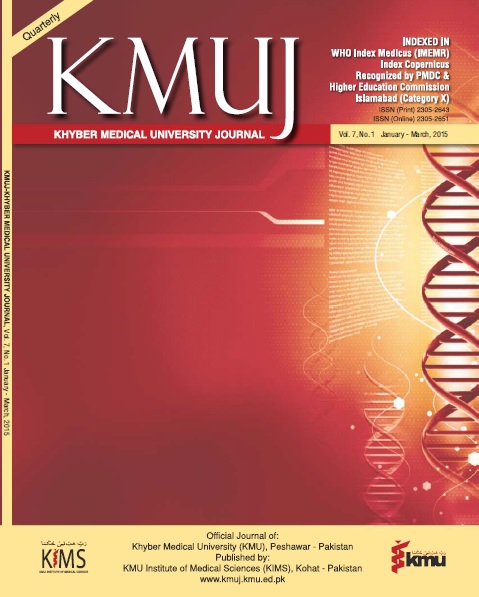EFFICACY OF USE OF APPENDIX AS MITROFANOFF CONDUIT IN URINARY DIVERSION
Main Article Content
Abstract
ABSTRACT
OBJECTIVE: to study the efficacy and safety of using appendix as catheterizable conduit based on Mitrofanoff procedure in urinary diversion.
METHODOLOGY: This prospective observational study was conducted at department of surgery, Hayatabad medical complex and Khyber teaching hospital from 1st January 2005 till 31st December 2011. Total number of 56 patients (38 males and 18 females) from 5-60 years of age were included in the study. Mitrofanoff principle was used to achieve clean intermittent catheterization and urinary continence. Patients were followed for two years with, initially 3 months and then 6 months intervals. All the data was collected on structured proforma and was analyzed on SPSS.
RESULTS: Out of 56 total patient, primary diagnosis was transitional cell carcinoma in 23 (41%) case, exstrophy-epispadias in 10(17.9%), urethral injury in 7(12.5%) cases and miscellaneous in 16 (28.5%) cases. Augmentation cystoplasty was performed in 9 (16%) and 33(58.9%) patients had neobladder formation in conjunction with Mitrofanoff procedure. Urinary continence was achieved in 51(91%) patients. Mortality rate was 3.5% (n=2/56) and 3(5.3%) patients were lost to follow up. Complications were observed in 18 (35.2%) cases. Stomal stenosis was most common complication in 7(12.5%) patients, followed by incisional hernia, wound infection, suprapubic fistula and intestinal obstruction in 2 (3.9%) patients each. Only 7 (13.7%) needed surgical management, rest of 11(21.5%) were treated conservatively.
CONCLUSION: Mitrofanoff procedure provides immense advantage to patients needing urinary diversion, as it is associated with far less complications, higher continence rate and greatly improved level of independence in bladder management.
KEY WORDS: Radical cystectomy, Urinary diversion, Mitrofanoff principle.
Article Details
Work published in KMUJ is licensed under a
Creative Commons Attribution 4.0 License
Authors are permitted and encouraged to post their work online (e.g., in institutional repositories or on their website) prior to and during the submission process, as it can lead to productive exchanges, as well as earlier and greater citation of published work.
(e.g., in institutional repositories or on their website) prior to and during the submission process, as it can lead to productive exchanges, as well as earlier and greater citation of published work.
References
Rowland RG, Mitchell ME, Bihrle R.Urinary diversion via a continent ileal reservoir.J Urol 1975;113:1136-9.
Veeratterapillay R, Morton H.Andrew C.Indian.Reconstructing the lower urinary tarct:The Mitrofanoff principle. J.Urol 2013;29(4): 316-21
Mitrofanoff P.Cystotomie continente transappendiculaire dans le traitement des vessies neurologiques.Chir Pediatr 1980;21:297-305
Basavaraj D,Vineet A,Simon C. The continent, catheterizable abdominal conduit in adult urological practice. BUJI 2008;102:1688-92
Marcelo F,Antonia A,Adauto J. Continent urinary diversion with short appendices in
obese patients: the initial results of a surgical option. J Surg 2013; 1(2): 22-7
Heij HA,Ekkelkamp S,Moorman-Voestermans GC,Vos A.Application of Mitrofanoff principle in children with severe impairment of bladder function.Pediatr surg Int 1997;12:286_8
Suzer O,Vates TS,Freedman AL,Smith CA,Gonzalez R.Results of the mitrofanoff procedure in urinary tract reconstruction in children.Br J Urol 1997;79(2): 279-82.
Mor Y, Kajbafzadeh AM, German K, Mouriquand PD, Duffy PG, Ransley PG. The role of ureter in the creation of Mitrofanoff channels in children. J Urol 1997;157:635-7.
Van Savage JG, Khoury AE, McLorie GA, Churchill BM. Outcome analysis of Mitrofanoff principle applications using appendix and ureter to umbilical and lower quadrant stomal sites. J Urol 1996;156:1794-7.
Lapides J.Dionko AC,Gould ER,Lowe BS.Further observations on self catheterization.J Urol 1976;116;169-71
Sylora JA,Gonzalez R,Reinberg Y.Self intermittent catheterization by quadriplegics via Mitrofanoff catheterizable channel.J Urol 1997;157:48-50
Rajendra Bi, Mallikarjun, Shishir D. Laparoscopic mitrofanoff appendicovesicostomy Indian J Urol 2012 Jan-Mar; 28(1): 28–31.
Wheeler R,Malone P. Use of the appendix in reconstructive surgery: A case against incidental appendicectomy.BJS 1991;78:1283-85.
Liard A, Séguier-Lipszyc E, Mathiot A, Mitrofanoff P. The Mitrofanoff procedure: 20 years later. J Urol 2001;165:2394–8.
Merenda LA,Duffy T,Betz RR,Mulcahey MJ,Dean G,Pontari M.Outcomes of Urinary Diversion in Children With Spinal Cord Injuries Lisa A.J spinal cord med 2007;30:41-7.
Murthi GV, Kelly JH. V-V plasty, A new technique for providing a resilient skin-lined opening for the Mitrofanoff stoma.J Urol 2006;68(3):661-2.
Sultan S, Hussain I, Ahmed B, Aba Umer S, Saulat S, Naqvi SA, et al. Clean intermittent catheterization in children through a continent catheterizable channel: A developing country experience.J Urol 2008;180:1852–5
Andreou P, Blain S, Boulay CEH Du. A histopathological study of the appendix at autopsy and after surgical resection. Histopathology 1990; 17: 427–31
Farrugia MK, Malone PS. Educational article: The Mitrofanoff procedure. J Pediatr Urol 2010;6:330
Sahadevan K, Pickard RS, Neal DE, Hasan TS. Is continent diversion using the Mitrofanoff principle a viable long-term option for adults requiring bladder replacement? BJU Int 2008;102:236-40.
Spahn M, Kocot A, Loeser A, Kneitz B, Riedmiller H. Last resort in devastated bladder outlet: Bladder
neck closure and continent vesicostomy - Long-term results and comparison of different techniques.Urol 2010;75:1185-92.
